Business Management Report: Stryker's Workforce Recruitment Challenges
VerifiedAdded on 2020/03/16
|11
|2364
|46
Report
AI Summary
This report provides an analysis of the challenges faced by Stryker Company in its workforce recruitment efforts. The report highlights key issues such as the impact of organizational image on attracting talent, the influence of current labor market dynamics, and the challenges posed by demographic factors including an aging workforce, the millennial generation, and workforce diversity. It also discusses the company's recruitment strategies, its partnership with Gallup, and the importance of strategic human resource planning. The report recommends that Stryker adopt strategies to address these challenges, including offering training and career progression opportunities, fostering a culture of diversity, and effectively utilizing strategic human resource planning techniques to forecast staffing needs. The conclusion emphasizes the importance of a positive organizational image and the use of online recruitment platforms.
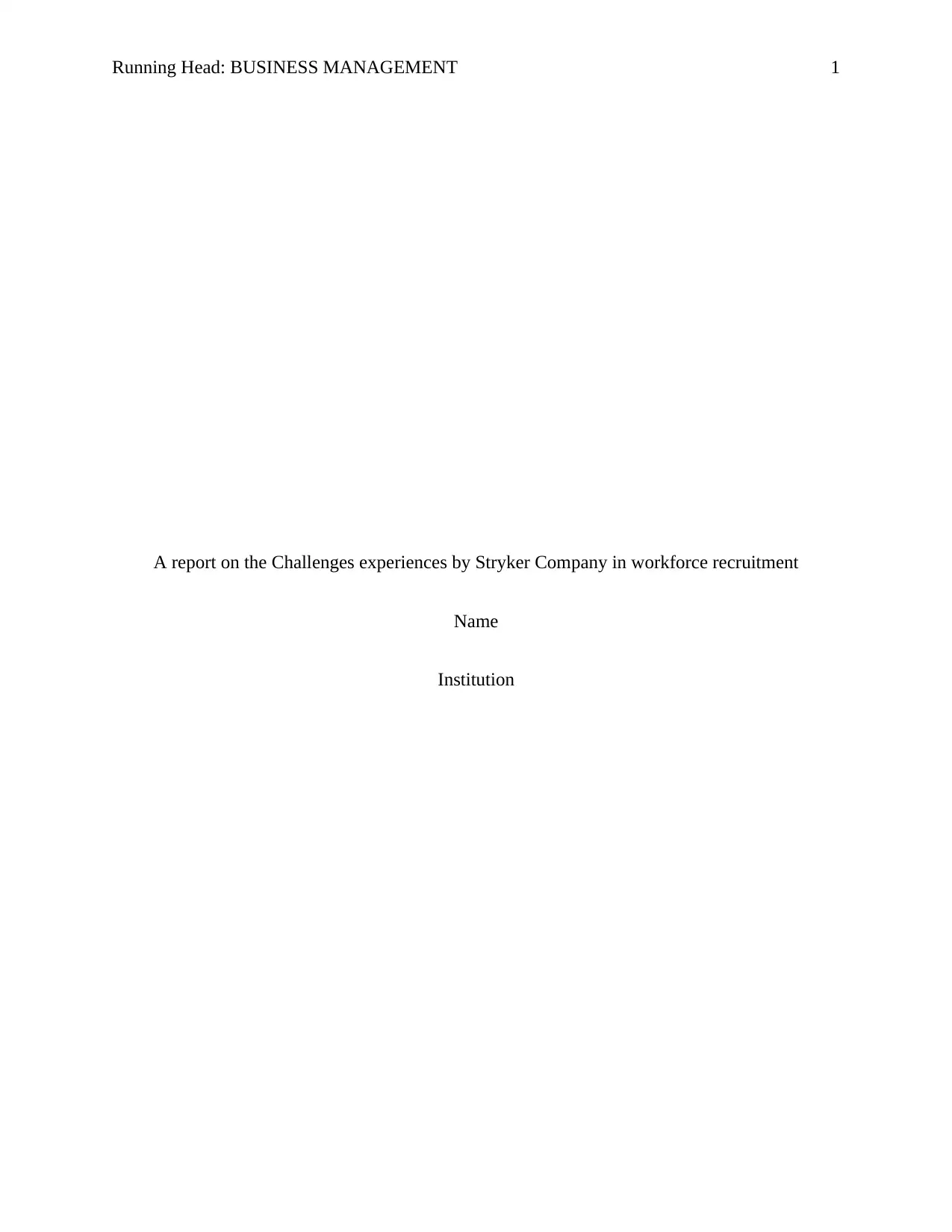
Running Head: BUSINESS MANAGEMENT 1
A report on the Challenges experiences by Stryker Company in workforce recruitment
Name
Institution
A report on the Challenges experiences by Stryker Company in workforce recruitment
Name
Institution
Paraphrase This Document
Need a fresh take? Get an instant paraphrase of this document with our AI Paraphraser
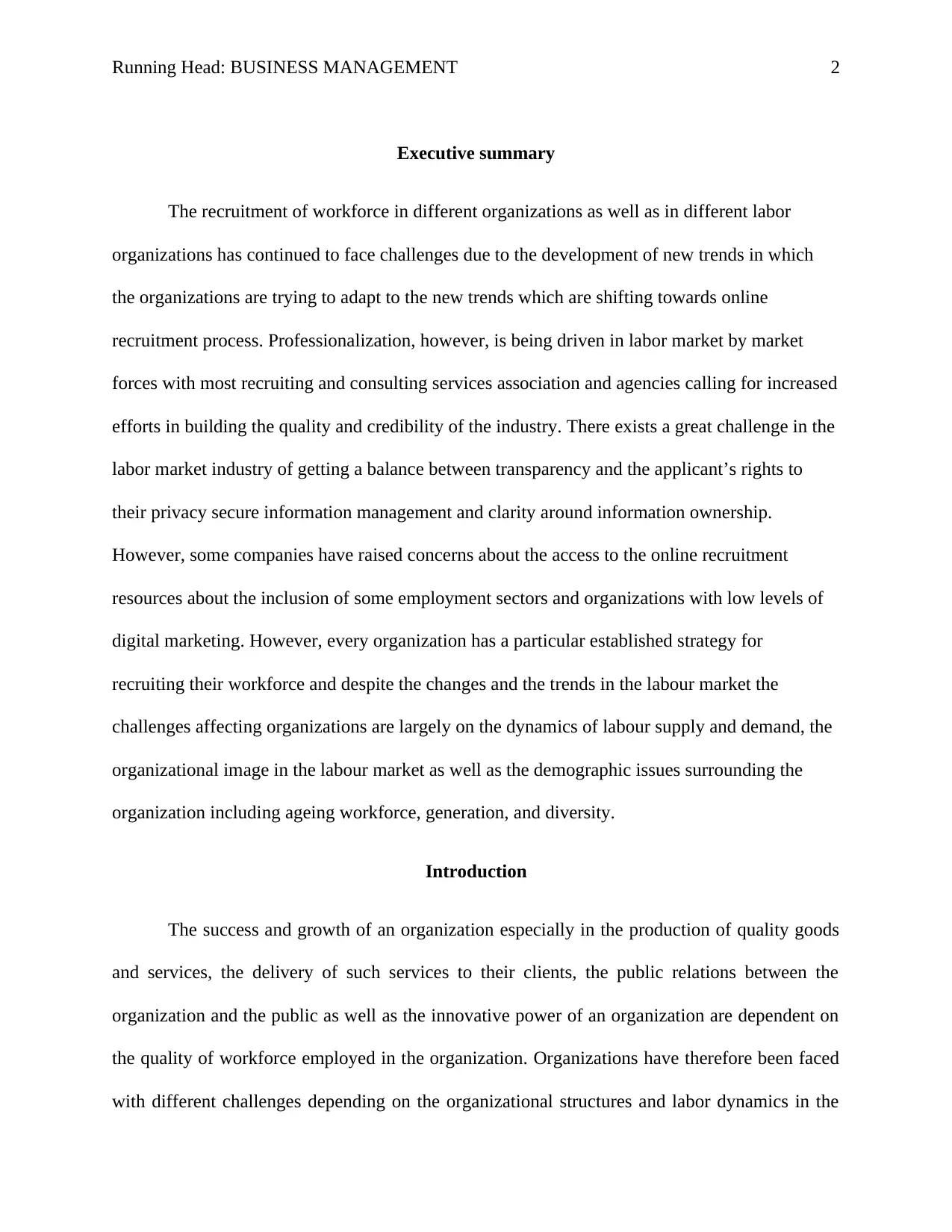
Running Head: BUSINESS MANAGEMENT 2
Executive summary
The recruitment of workforce in different organizations as well as in different labor
organizations has continued to face challenges due to the development of new trends in which
the organizations are trying to adapt to the new trends which are shifting towards online
recruitment process. Professionalization, however, is being driven in labor market by market
forces with most recruiting and consulting services association and agencies calling for increased
efforts in building the quality and credibility of the industry. There exists a great challenge in the
labor market industry of getting a balance between transparency and the applicant’s rights to
their privacy secure information management and clarity around information ownership.
However, some companies have raised concerns about the access to the online recruitment
resources about the inclusion of some employment sectors and organizations with low levels of
digital marketing. However, every organization has a particular established strategy for
recruiting their workforce and despite the changes and the trends in the labour market the
challenges affecting organizations are largely on the dynamics of labour supply and demand, the
organizational image in the labour market as well as the demographic issues surrounding the
organization including ageing workforce, generation, and diversity.
Introduction
The success and growth of an organization especially in the production of quality goods
and services, the delivery of such services to their clients, the public relations between the
organization and the public as well as the innovative power of an organization are dependent on
the quality of workforce employed in the organization. Organizations have therefore been faced
with different challenges depending on the organizational structures and labor dynamics in the
Executive summary
The recruitment of workforce in different organizations as well as in different labor
organizations has continued to face challenges due to the development of new trends in which
the organizations are trying to adapt to the new trends which are shifting towards online
recruitment process. Professionalization, however, is being driven in labor market by market
forces with most recruiting and consulting services association and agencies calling for increased
efforts in building the quality and credibility of the industry. There exists a great challenge in the
labor market industry of getting a balance between transparency and the applicant’s rights to
their privacy secure information management and clarity around information ownership.
However, some companies have raised concerns about the access to the online recruitment
resources about the inclusion of some employment sectors and organizations with low levels of
digital marketing. However, every organization has a particular established strategy for
recruiting their workforce and despite the changes and the trends in the labour market the
challenges affecting organizations are largely on the dynamics of labour supply and demand, the
organizational image in the labour market as well as the demographic issues surrounding the
organization including ageing workforce, generation, and diversity.
Introduction
The success and growth of an organization especially in the production of quality goods
and services, the delivery of such services to their clients, the public relations between the
organization and the public as well as the innovative power of an organization are dependent on
the quality of workforce employed in the organization. Organizations have therefore been faced
with different challenges depending on the organizational structures and labor dynamics in the
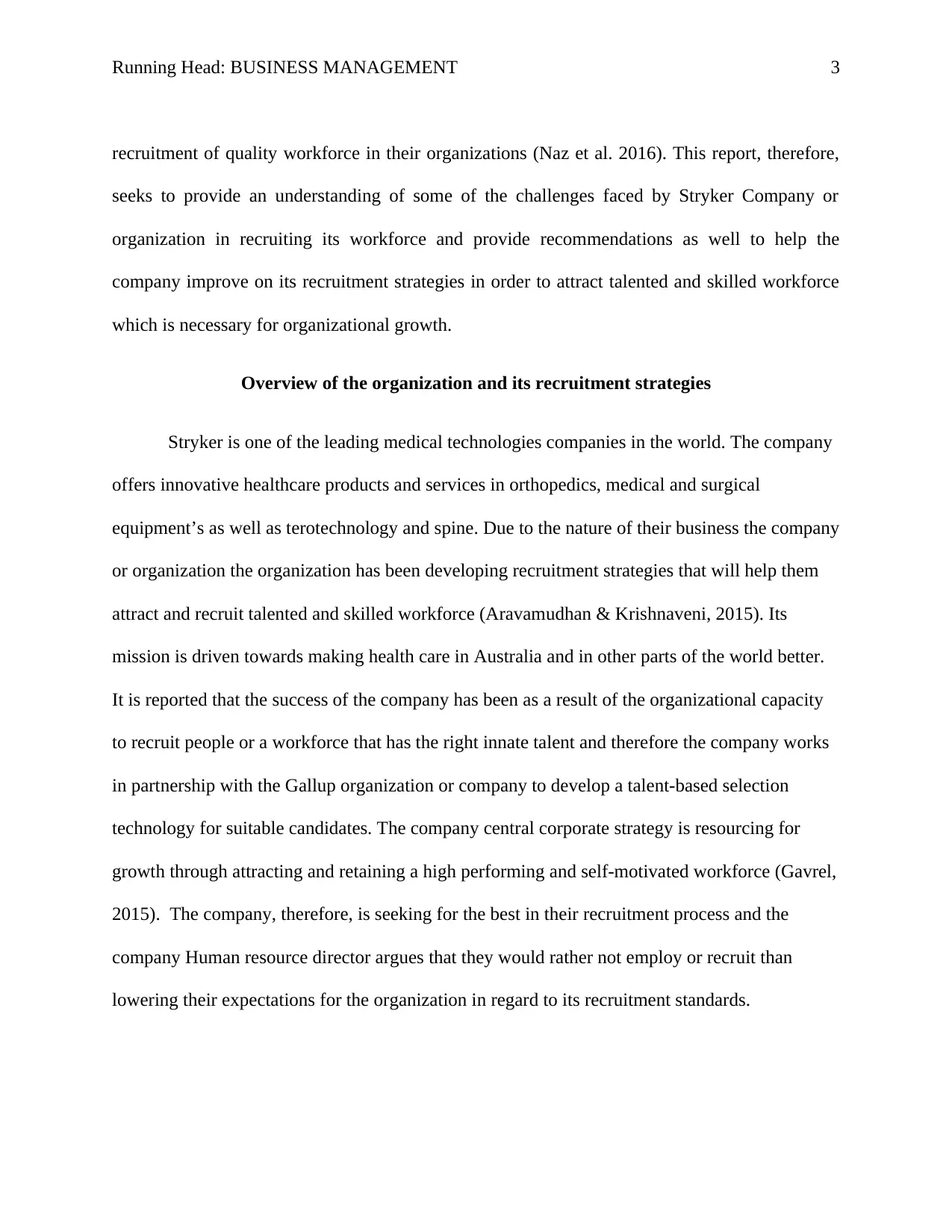
Running Head: BUSINESS MANAGEMENT 3
recruitment of quality workforce in their organizations (Naz et al. 2016). This report, therefore,
seeks to provide an understanding of some of the challenges faced by Stryker Company or
organization in recruiting its workforce and provide recommendations as well to help the
company improve on its recruitment strategies in order to attract talented and skilled workforce
which is necessary for organizational growth.
Overview of the organization and its recruitment strategies
Stryker is one of the leading medical technologies companies in the world. The company
offers innovative healthcare products and services in orthopedics, medical and surgical
equipment’s as well as terotechnology and spine. Due to the nature of their business the company
or organization the organization has been developing recruitment strategies that will help them
attract and recruit talented and skilled workforce (Aravamudhan & Krishnaveni, 2015). Its
mission is driven towards making health care in Australia and in other parts of the world better.
It is reported that the success of the company has been as a result of the organizational capacity
to recruit people or a workforce that has the right innate talent and therefore the company works
in partnership with the Gallup organization or company to develop a talent-based selection
technology for suitable candidates. The company central corporate strategy is resourcing for
growth through attracting and retaining a high performing and self-motivated workforce (Gavrel,
2015). The company, therefore, is seeking for the best in their recruitment process and the
company Human resource director argues that they would rather not employ or recruit than
lowering their expectations for the organization in regard to its recruitment standards.
recruitment of quality workforce in their organizations (Naz et al. 2016). This report, therefore,
seeks to provide an understanding of some of the challenges faced by Stryker Company or
organization in recruiting its workforce and provide recommendations as well to help the
company improve on its recruitment strategies in order to attract talented and skilled workforce
which is necessary for organizational growth.
Overview of the organization and its recruitment strategies
Stryker is one of the leading medical technologies companies in the world. The company
offers innovative healthcare products and services in orthopedics, medical and surgical
equipment’s as well as terotechnology and spine. Due to the nature of their business the company
or organization the organization has been developing recruitment strategies that will help them
attract and recruit talented and skilled workforce (Aravamudhan & Krishnaveni, 2015). Its
mission is driven towards making health care in Australia and in other parts of the world better.
It is reported that the success of the company has been as a result of the organizational capacity
to recruit people or a workforce that has the right innate talent and therefore the company works
in partnership with the Gallup organization or company to develop a talent-based selection
technology for suitable candidates. The company central corporate strategy is resourcing for
growth through attracting and retaining a high performing and self-motivated workforce (Gavrel,
2015). The company, therefore, is seeking for the best in their recruitment process and the
company Human resource director argues that they would rather not employ or recruit than
lowering their expectations for the organization in regard to its recruitment standards.
⊘ This is a preview!⊘
Do you want full access?
Subscribe today to unlock all pages.

Trusted by 1+ million students worldwide
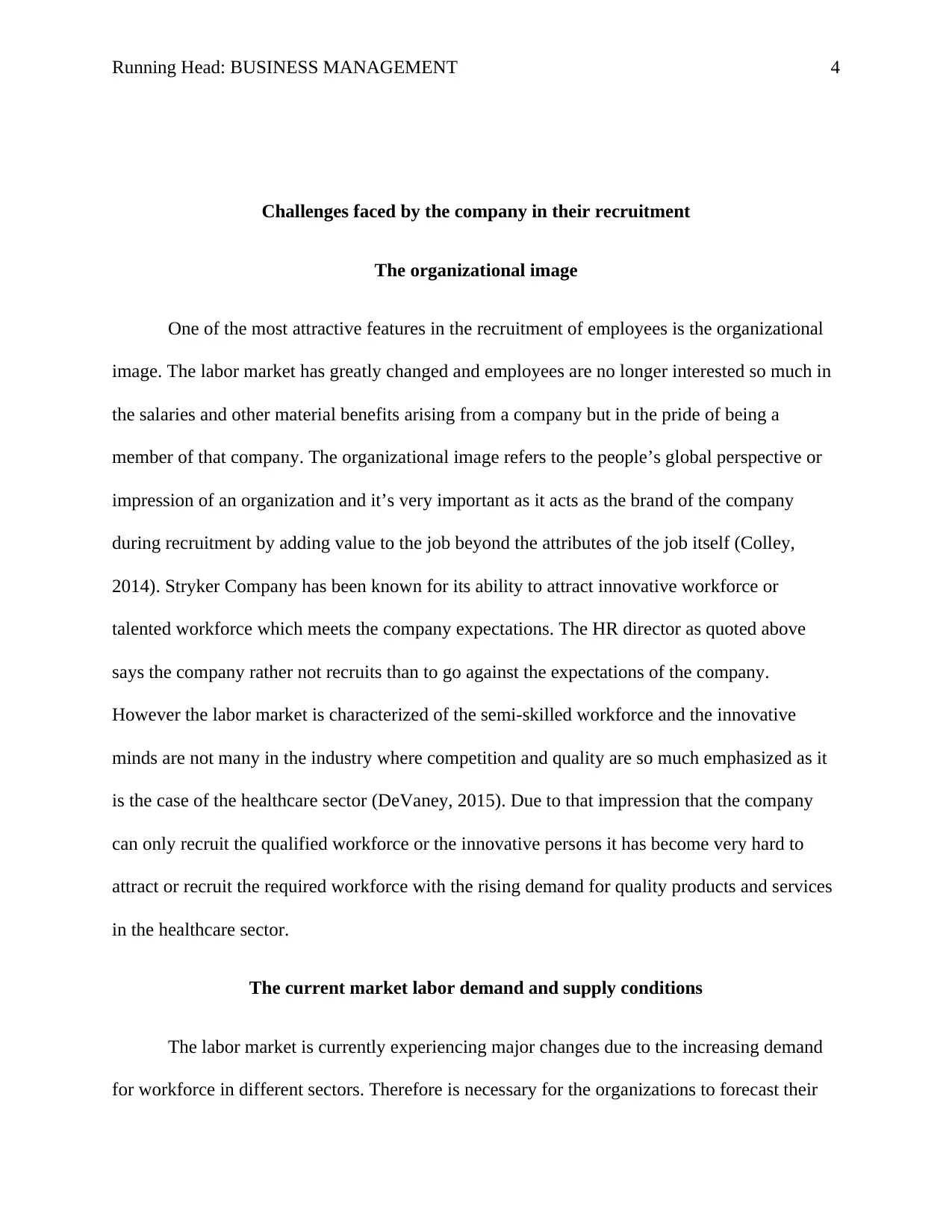
Running Head: BUSINESS MANAGEMENT 4
Challenges faced by the company in their recruitment
The organizational image
One of the most attractive features in the recruitment of employees is the organizational
image. The labor market has greatly changed and employees are no longer interested so much in
the salaries and other material benefits arising from a company but in the pride of being a
member of that company. The organizational image refers to the people’s global perspective or
impression of an organization and it’s very important as it acts as the brand of the company
during recruitment by adding value to the job beyond the attributes of the job itself (Colley,
2014). Stryker Company has been known for its ability to attract innovative workforce or
talented workforce which meets the company expectations. The HR director as quoted above
says the company rather not recruits than to go against the expectations of the company.
However the labor market is characterized of the semi-skilled workforce and the innovative
minds are not many in the industry where competition and quality are so much emphasized as it
is the case of the healthcare sector (DeVaney, 2015). Due to that impression that the company
can only recruit the qualified workforce or the innovative persons it has become very hard to
attract or recruit the required workforce with the rising demand for quality products and services
in the healthcare sector.
The current market labor demand and supply conditions
The labor market is currently experiencing major changes due to the increasing demand
for workforce in different sectors. Therefore is necessary for the organizations to forecast their
Challenges faced by the company in their recruitment
The organizational image
One of the most attractive features in the recruitment of employees is the organizational
image. The labor market has greatly changed and employees are no longer interested so much in
the salaries and other material benefits arising from a company but in the pride of being a
member of that company. The organizational image refers to the people’s global perspective or
impression of an organization and it’s very important as it acts as the brand of the company
during recruitment by adding value to the job beyond the attributes of the job itself (Colley,
2014). Stryker Company has been known for its ability to attract innovative workforce or
talented workforce which meets the company expectations. The HR director as quoted above
says the company rather not recruits than to go against the expectations of the company.
However the labor market is characterized of the semi-skilled workforce and the innovative
minds are not many in the industry where competition and quality are so much emphasized as it
is the case of the healthcare sector (DeVaney, 2015). Due to that impression that the company
can only recruit the qualified workforce or the innovative persons it has become very hard to
attract or recruit the required workforce with the rising demand for quality products and services
in the healthcare sector.
The current market labor demand and supply conditions
The labor market is currently experiencing major changes due to the increasing demand
for workforce in different sectors. Therefore is necessary for the organizations to forecast their
Paraphrase This Document
Need a fresh take? Get an instant paraphrase of this document with our AI Paraphraser
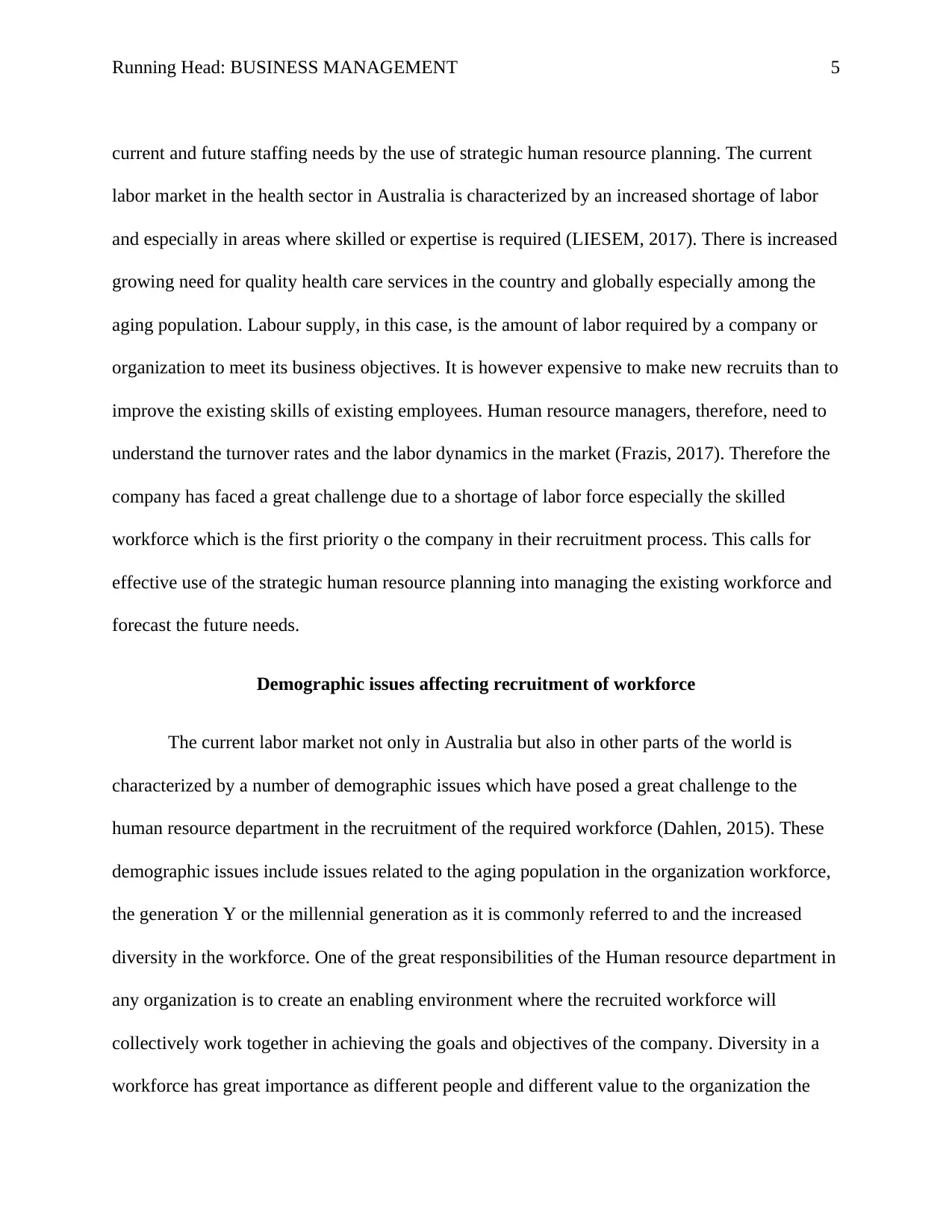
Running Head: BUSINESS MANAGEMENT 5
current and future staffing needs by the use of strategic human resource planning. The current
labor market in the health sector in Australia is characterized by an increased shortage of labor
and especially in areas where skilled or expertise is required (LIESEM, 2017). There is increased
growing need for quality health care services in the country and globally especially among the
aging population. Labour supply, in this case, is the amount of labor required by a company or
organization to meet its business objectives. It is however expensive to make new recruits than to
improve the existing skills of existing employees. Human resource managers, therefore, need to
understand the turnover rates and the labor dynamics in the market (Frazis, 2017). Therefore the
company has faced a great challenge due to a shortage of labor force especially the skilled
workforce which is the first priority o the company in their recruitment process. This calls for
effective use of the strategic human resource planning into managing the existing workforce and
forecast the future needs.
Demographic issues affecting recruitment of workforce
The current labor market not only in Australia but also in other parts of the world is
characterized by a number of demographic issues which have posed a great challenge to the
human resource department in the recruitment of the required workforce (Dahlen, 2015). These
demographic issues include issues related to the aging population in the organization workforce,
the generation Y or the millennial generation as it is commonly referred to and the increased
diversity in the workforce. One of the great responsibilities of the Human resource department in
any organization is to create an enabling environment where the recruited workforce will
collectively work together in achieving the goals and objectives of the company. Diversity in a
workforce has great importance as different people and different value to the organization the
current and future staffing needs by the use of strategic human resource planning. The current
labor market in the health sector in Australia is characterized by an increased shortage of labor
and especially in areas where skilled or expertise is required (LIESEM, 2017). There is increased
growing need for quality health care services in the country and globally especially among the
aging population. Labour supply, in this case, is the amount of labor required by a company or
organization to meet its business objectives. It is however expensive to make new recruits than to
improve the existing skills of existing employees. Human resource managers, therefore, need to
understand the turnover rates and the labor dynamics in the market (Frazis, 2017). Therefore the
company has faced a great challenge due to a shortage of labor force especially the skilled
workforce which is the first priority o the company in their recruitment process. This calls for
effective use of the strategic human resource planning into managing the existing workforce and
forecast the future needs.
Demographic issues affecting recruitment of workforce
The current labor market not only in Australia but also in other parts of the world is
characterized by a number of demographic issues which have posed a great challenge to the
human resource department in the recruitment of the required workforce (Dahlen, 2015). These
demographic issues include issues related to the aging population in the organization workforce,
the generation Y or the millennial generation as it is commonly referred to and the increased
diversity in the workforce. One of the great responsibilities of the Human resource department in
any organization is to create an enabling environment where the recruited workforce will
collectively work together in achieving the goals and objectives of the company. Diversity in a
workforce has great importance as different people and different value to the organization the

Running Head: BUSINESS MANAGEMENT 6
company, therefore, faces a challenge of having a diversified workforce as it is composed of
experienced aged and innovative employees (Alameddine et al. 2017). The labor force has
increasingly become diverse which has necessitated the organization to change their approaches
to management or their workforce.
The company due to the fact that it recruits talented and innovative minds, there is a great
tendency that these people will stay for a long period in the organization (Brown et al. 2014). An
aging workforce means that there is a greater concentration of aged people in the workforce and
requires the human resources to develop management strategies for the aged population through
training, occupational health care and employment benefits which in turn increase operational
costs for the company. There exist intergenerational conflicts as the aged population or
workforce may seem to block the path of progression for their younger colleagues. The company
also has a great challenge of recruiting the young generation or Generation Y as commonly
known. The young generation brings about great management challenges to the human resource
managers (Kahn, 2015). This generation is feared by many organizations despite bringing new
talents and innovative minds to the organization which will add more value to the organization as
they usually have high expectations from their employers which seem to give the human
resource managers more pressure. They are also focused on their immediate future than looking
into their long-term future with the company yet recruiters are looking for a workforce that will
provide long-term support and value to the company (Wilson &Spoehr, 2015). This has been a
great challenge as the company is seeking for these young innovative minds yet their
management may be difficult in the organization.
Recommendations
company, therefore, faces a challenge of having a diversified workforce as it is composed of
experienced aged and innovative employees (Alameddine et al. 2017). The labor force has
increasingly become diverse which has necessitated the organization to change their approaches
to management or their workforce.
The company due to the fact that it recruits talented and innovative minds, there is a great
tendency that these people will stay for a long period in the organization (Brown et al. 2014). An
aging workforce means that there is a greater concentration of aged people in the workforce and
requires the human resources to develop management strategies for the aged population through
training, occupational health care and employment benefits which in turn increase operational
costs for the company. There exist intergenerational conflicts as the aged population or
workforce may seem to block the path of progression for their younger colleagues. The company
also has a great challenge of recruiting the young generation or Generation Y as commonly
known. The young generation brings about great management challenges to the human resource
managers (Kahn, 2015). This generation is feared by many organizations despite bringing new
talents and innovative minds to the organization which will add more value to the organization as
they usually have high expectations from their employers which seem to give the human
resource managers more pressure. They are also focused on their immediate future than looking
into their long-term future with the company yet recruiters are looking for a workforce that will
provide long-term support and value to the company (Wilson &Spoehr, 2015). This has been a
great challenge as the company is seeking for these young innovative minds yet their
management may be difficult in the organization.
Recommendations
⊘ This is a preview!⊘
Do you want full access?
Subscribe today to unlock all pages.

Trusted by 1+ million students worldwide
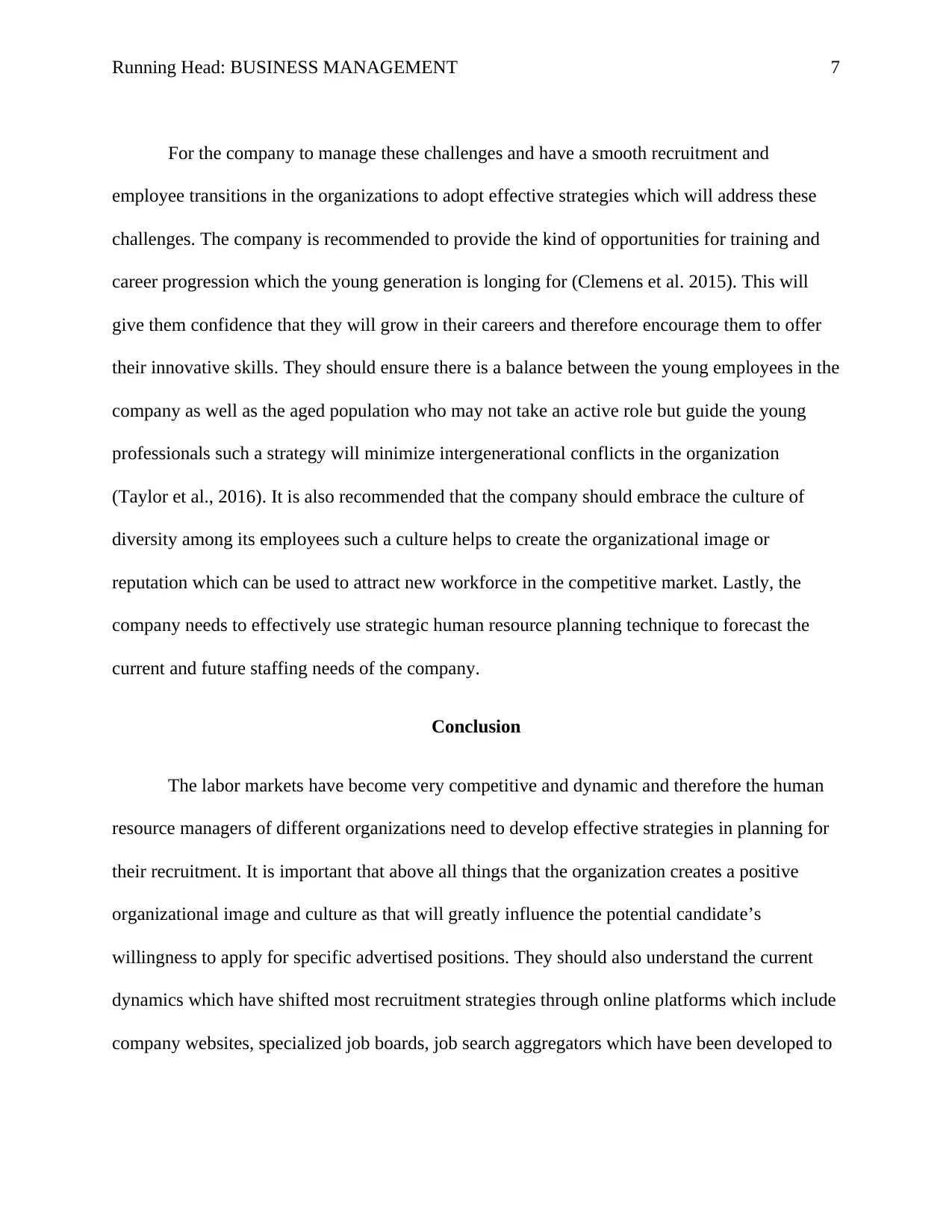
Running Head: BUSINESS MANAGEMENT 7
For the company to manage these challenges and have a smooth recruitment and
employee transitions in the organizations to adopt effective strategies which will address these
challenges. The company is recommended to provide the kind of opportunities for training and
career progression which the young generation is longing for (Clemens et al. 2015). This will
give them confidence that they will grow in their careers and therefore encourage them to offer
their innovative skills. They should ensure there is a balance between the young employees in the
company as well as the aged population who may not take an active role but guide the young
professionals such a strategy will minimize intergenerational conflicts in the organization
(Taylor et al., 2016). It is also recommended that the company should embrace the culture of
diversity among its employees such a culture helps to create the organizational image or
reputation which can be used to attract new workforce in the competitive market. Lastly, the
company needs to effectively use strategic human resource planning technique to forecast the
current and future staffing needs of the company.
Conclusion
The labor markets have become very competitive and dynamic and therefore the human
resource managers of different organizations need to develop effective strategies in planning for
their recruitment. It is important that above all things that the organization creates a positive
organizational image and culture as that will greatly influence the potential candidate’s
willingness to apply for specific advertised positions. They should also understand the current
dynamics which have shifted most recruitment strategies through online platforms which include
company websites, specialized job boards, job search aggregators which have been developed to
For the company to manage these challenges and have a smooth recruitment and
employee transitions in the organizations to adopt effective strategies which will address these
challenges. The company is recommended to provide the kind of opportunities for training and
career progression which the young generation is longing for (Clemens et al. 2015). This will
give them confidence that they will grow in their careers and therefore encourage them to offer
their innovative skills. They should ensure there is a balance between the young employees in the
company as well as the aged population who may not take an active role but guide the young
professionals such a strategy will minimize intergenerational conflicts in the organization
(Taylor et al., 2016). It is also recommended that the company should embrace the culture of
diversity among its employees such a culture helps to create the organizational image or
reputation which can be used to attract new workforce in the competitive market. Lastly, the
company needs to effectively use strategic human resource planning technique to forecast the
current and future staffing needs of the company.
Conclusion
The labor markets have become very competitive and dynamic and therefore the human
resource managers of different organizations need to develop effective strategies in planning for
their recruitment. It is important that above all things that the organization creates a positive
organizational image and culture as that will greatly influence the potential candidate’s
willingness to apply for specific advertised positions. They should also understand the current
dynamics which have shifted most recruitment strategies through online platforms which include
company websites, specialized job boards, job search aggregators which have been developed to
Paraphrase This Document
Need a fresh take? Get an instant paraphrase of this document with our AI Paraphraser
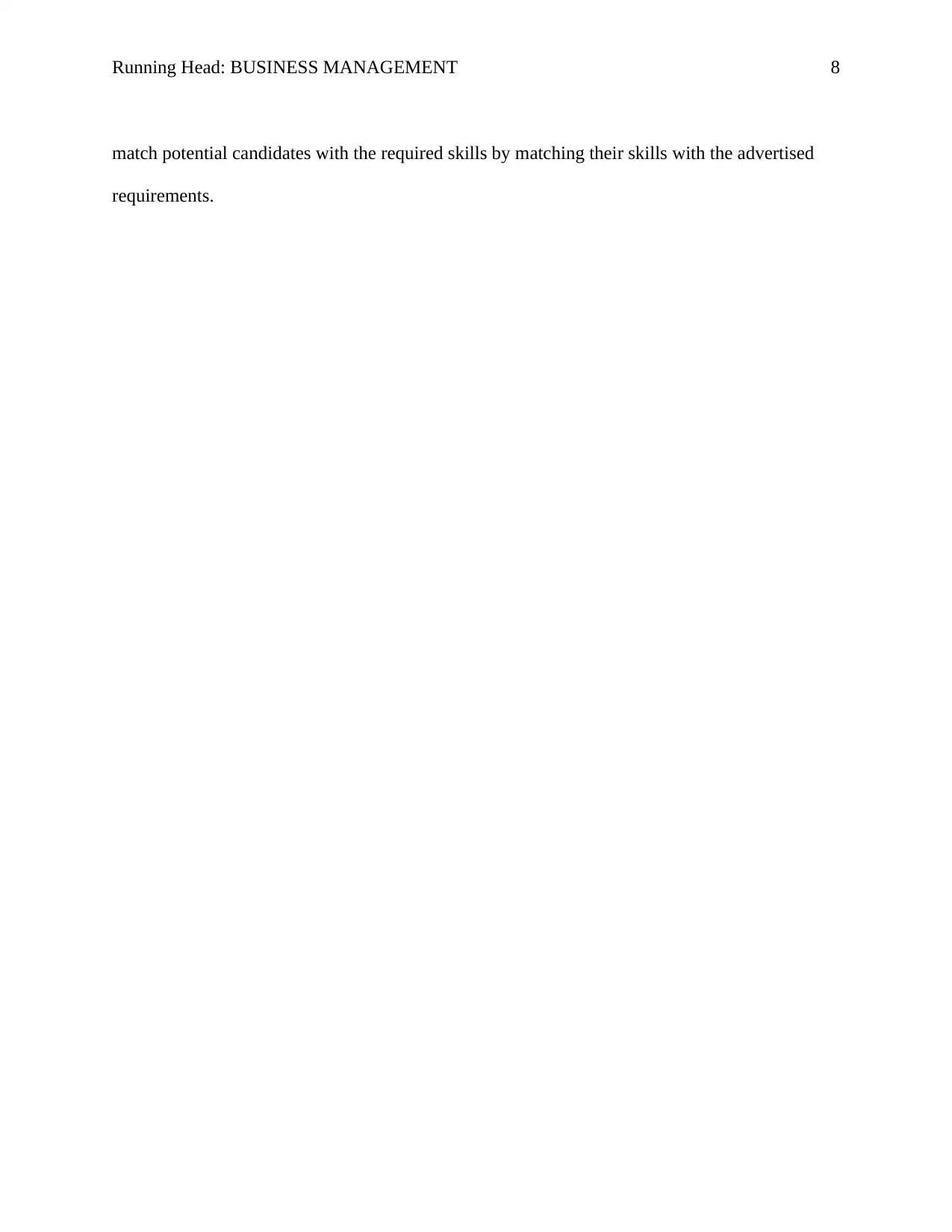
Running Head: BUSINESS MANAGEMENT 8
match potential candidates with the required skills by matching their skills with the advertised
requirements.
match potential candidates with the required skills by matching their skills with the advertised
requirements.
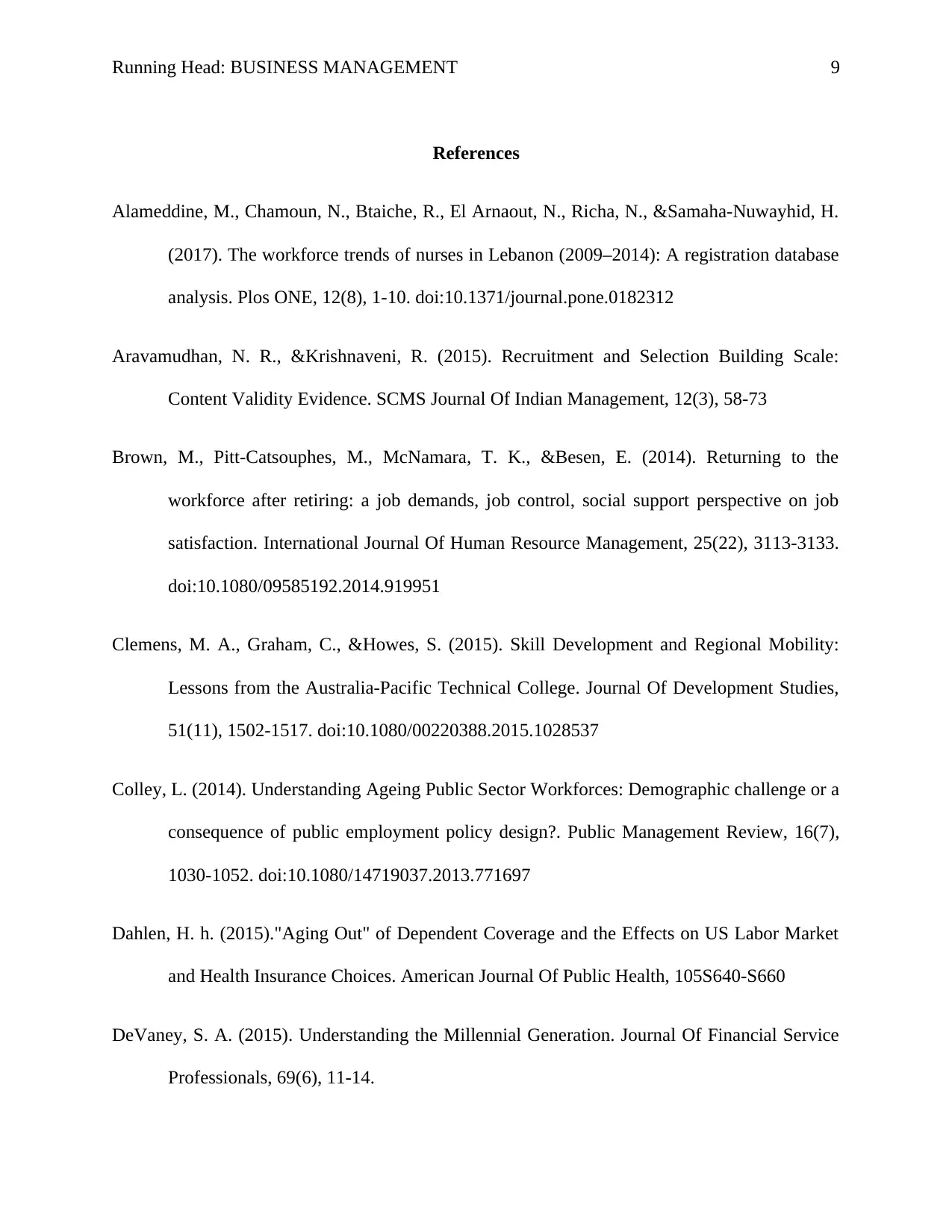
Running Head: BUSINESS MANAGEMENT 9
References
Alameddine, M., Chamoun, N., Btaiche, R., El Arnaout, N., Richa, N., &Samaha-Nuwayhid, H.
(2017). The workforce trends of nurses in Lebanon (2009–2014): A registration database
analysis. Plos ONE, 12(8), 1-10. doi:10.1371/journal.pone.0182312
Aravamudhan, N. R., &Krishnaveni, R. (2015). Recruitment and Selection Building Scale:
Content Validity Evidence. SCMS Journal Of Indian Management, 12(3), 58-73
Brown, M., Pitt-Catsouphes, M., McNamara, T. K., &Besen, E. (2014). Returning to the
workforce after retiring: a job demands, job control, social support perspective on job
satisfaction. International Journal Of Human Resource Management, 25(22), 3113-3133.
doi:10.1080/09585192.2014.919951
Clemens, M. A., Graham, C., &Howes, S. (2015). Skill Development and Regional Mobility:
Lessons from the Australia-Pacific Technical College. Journal Of Development Studies,
51(11), 1502-1517. doi:10.1080/00220388.2015.1028537
Colley, L. (2014). Understanding Ageing Public Sector Workforces: Demographic challenge or a
consequence of public employment policy design?. Public Management Review, 16(7),
1030-1052. doi:10.1080/14719037.2013.771697
Dahlen, H. h. (2015)."Aging Out" of Dependent Coverage and the Effects on US Labor Market
and Health Insurance Choices. American Journal Of Public Health, 105S640-S660
DeVaney, S. A. (2015). Understanding the Millennial Generation. Journal Of Financial Service
Professionals, 69(6), 11-14.
References
Alameddine, M., Chamoun, N., Btaiche, R., El Arnaout, N., Richa, N., &Samaha-Nuwayhid, H.
(2017). The workforce trends of nurses in Lebanon (2009–2014): A registration database
analysis. Plos ONE, 12(8), 1-10. doi:10.1371/journal.pone.0182312
Aravamudhan, N. R., &Krishnaveni, R. (2015). Recruitment and Selection Building Scale:
Content Validity Evidence. SCMS Journal Of Indian Management, 12(3), 58-73
Brown, M., Pitt-Catsouphes, M., McNamara, T. K., &Besen, E. (2014). Returning to the
workforce after retiring: a job demands, job control, social support perspective on job
satisfaction. International Journal Of Human Resource Management, 25(22), 3113-3133.
doi:10.1080/09585192.2014.919951
Clemens, M. A., Graham, C., &Howes, S. (2015). Skill Development and Regional Mobility:
Lessons from the Australia-Pacific Technical College. Journal Of Development Studies,
51(11), 1502-1517. doi:10.1080/00220388.2015.1028537
Colley, L. (2014). Understanding Ageing Public Sector Workforces: Demographic challenge or a
consequence of public employment policy design?. Public Management Review, 16(7),
1030-1052. doi:10.1080/14719037.2013.771697
Dahlen, H. h. (2015)."Aging Out" of Dependent Coverage and the Effects on US Labor Market
and Health Insurance Choices. American Journal Of Public Health, 105S640-S660
DeVaney, S. A. (2015). Understanding the Millennial Generation. Journal Of Financial Service
Professionals, 69(6), 11-14.
⊘ This is a preview!⊘
Do you want full access?
Subscribe today to unlock all pages.

Trusted by 1+ million students worldwide
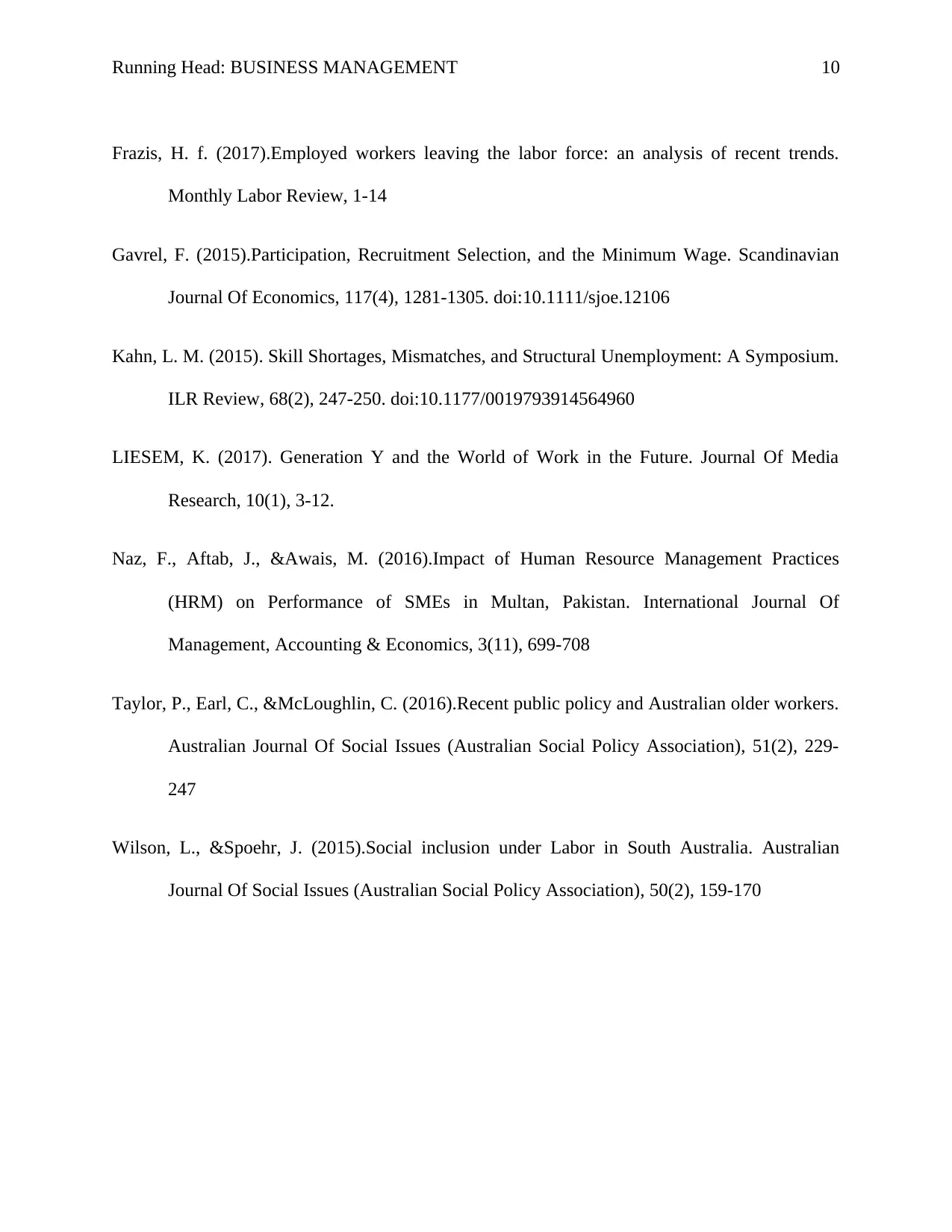
Running Head: BUSINESS MANAGEMENT 10
Frazis, H. f. (2017).Employed workers leaving the labor force: an analysis of recent trends.
Monthly Labor Review, 1-14
Gavrel, F. (2015).Participation, Recruitment Selection, and the Minimum Wage. Scandinavian
Journal Of Economics, 117(4), 1281-1305. doi:10.1111/sjoe.12106
Kahn, L. M. (2015). Skill Shortages, Mismatches, and Structural Unemployment: A Symposium.
ILR Review, 68(2), 247-250. doi:10.1177/0019793914564960
LIESEM, K. (2017). Generation Y and the World of Work in the Future. Journal Of Media
Research, 10(1), 3-12.
Naz, F., Aftab, J., &Awais, M. (2016).Impact of Human Resource Management Practices
(HRM) on Performance of SMEs in Multan, Pakistan. International Journal Of
Management, Accounting & Economics, 3(11), 699-708
Taylor, P., Earl, C., &McLoughlin, C. (2016).Recent public policy and Australian older workers.
Australian Journal Of Social Issues (Australian Social Policy Association), 51(2), 229-
247
Wilson, L., &Spoehr, J. (2015).Social inclusion under Labor in South Australia. Australian
Journal Of Social Issues (Australian Social Policy Association), 50(2), 159-170
Frazis, H. f. (2017).Employed workers leaving the labor force: an analysis of recent trends.
Monthly Labor Review, 1-14
Gavrel, F. (2015).Participation, Recruitment Selection, and the Minimum Wage. Scandinavian
Journal Of Economics, 117(4), 1281-1305. doi:10.1111/sjoe.12106
Kahn, L. M. (2015). Skill Shortages, Mismatches, and Structural Unemployment: A Symposium.
ILR Review, 68(2), 247-250. doi:10.1177/0019793914564960
LIESEM, K. (2017). Generation Y and the World of Work in the Future. Journal Of Media
Research, 10(1), 3-12.
Naz, F., Aftab, J., &Awais, M. (2016).Impact of Human Resource Management Practices
(HRM) on Performance of SMEs in Multan, Pakistan. International Journal Of
Management, Accounting & Economics, 3(11), 699-708
Taylor, P., Earl, C., &McLoughlin, C. (2016).Recent public policy and Australian older workers.
Australian Journal Of Social Issues (Australian Social Policy Association), 51(2), 229-
247
Wilson, L., &Spoehr, J. (2015).Social inclusion under Labor in South Australia. Australian
Journal Of Social Issues (Australian Social Policy Association), 50(2), 159-170
Paraphrase This Document
Need a fresh take? Get an instant paraphrase of this document with our AI Paraphraser
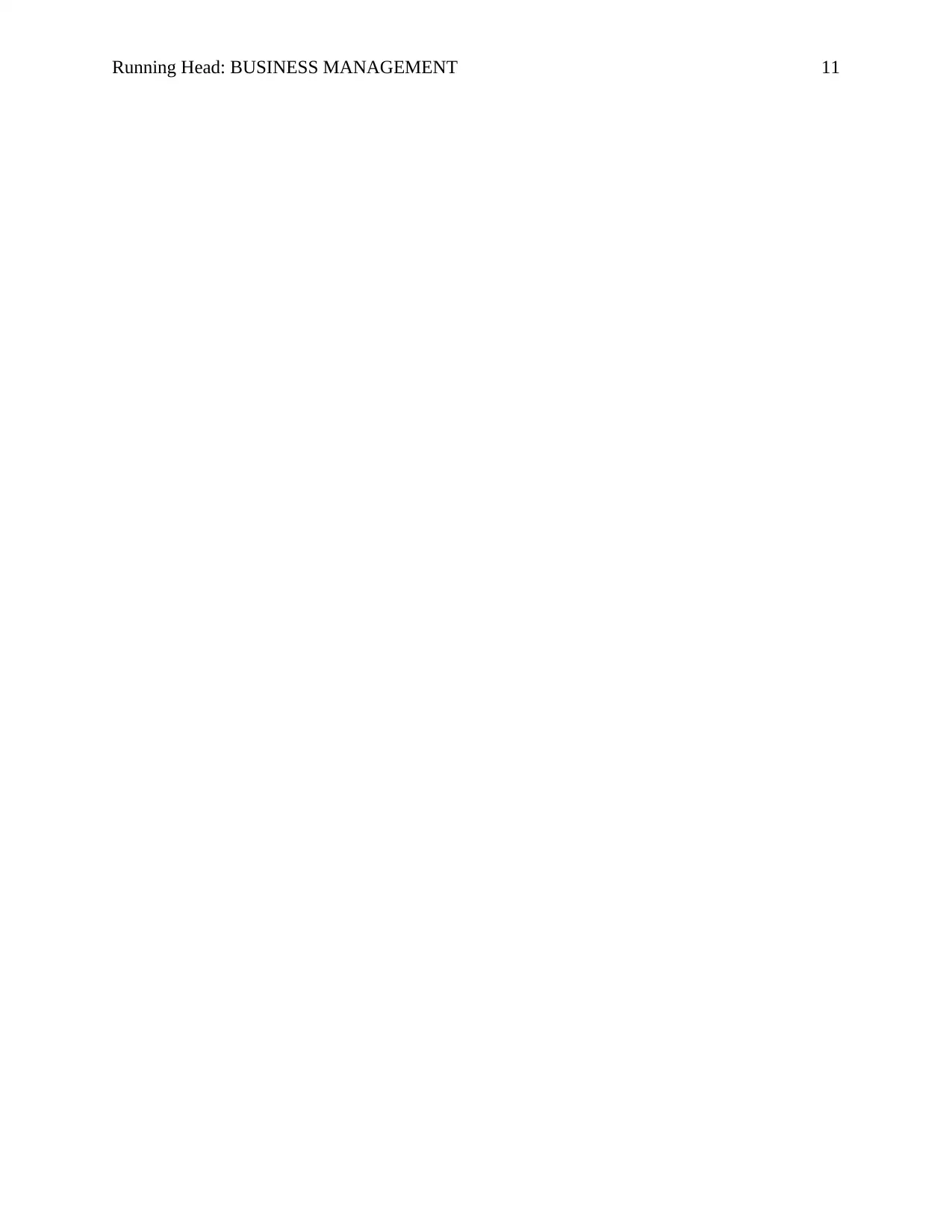
Running Head: BUSINESS MANAGEMENT 11
1 out of 11
Related Documents
Your All-in-One AI-Powered Toolkit for Academic Success.
+13062052269
info@desklib.com
Available 24*7 on WhatsApp / Email
![[object Object]](/_next/static/media/star-bottom.7253800d.svg)
Unlock your academic potential
Copyright © 2020–2025 A2Z Services. All Rights Reserved. Developed and managed by ZUCOL.




